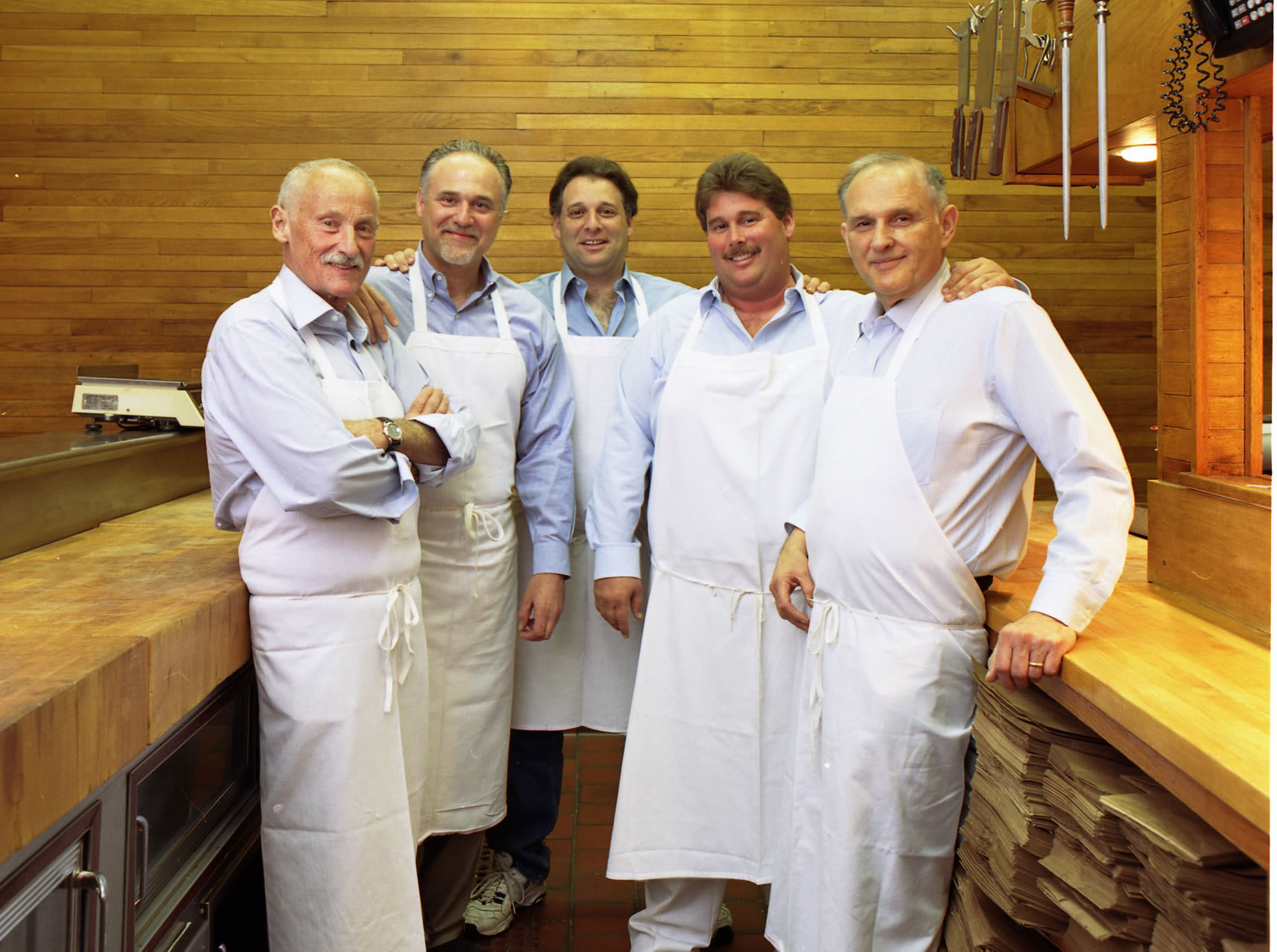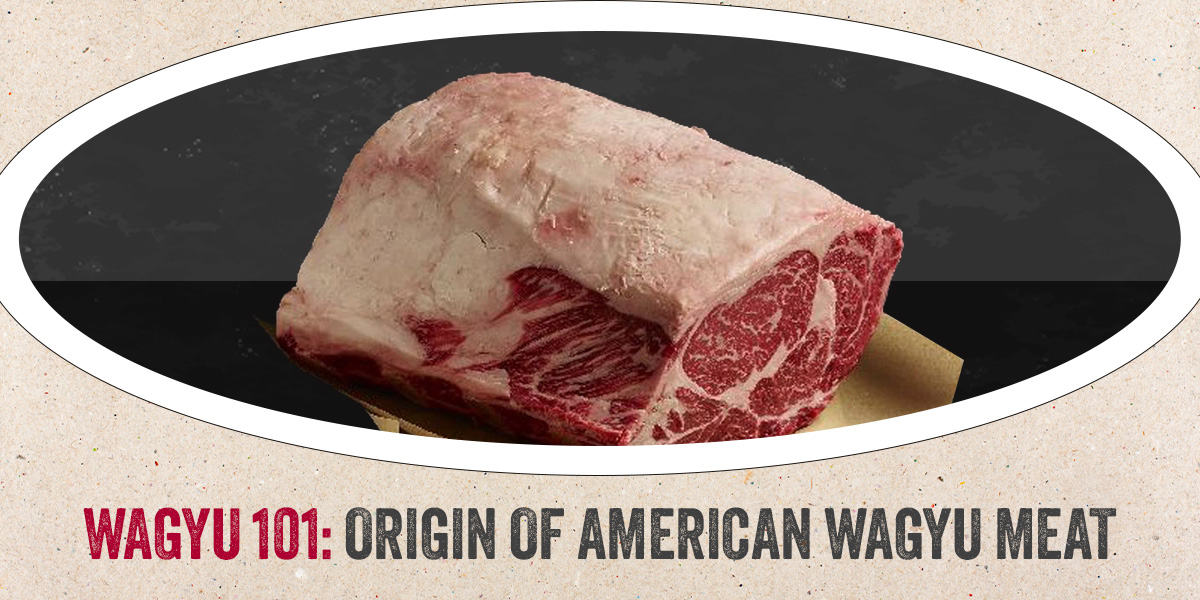
Wagyu 101: Origin of American Wagyu Meat
Few names get as much attention in the realm of premium beef as wagyu. It is admired for its exceptional marbling, flavor, and satisfying chew. From its origins in Japan to our doorstep in the U.S., it continuously captivates culinary enthusiasts. These cattle need specific husbandry practices to ensure the meat reaches its full potential. Their attention to animal health care, nutrition, and living conditions is a testimony to the high-quality products American farmers produce.
From its historical roots to modern breeding, learn more about where wagyu meat comes from, what American wagyu beef is, and how you can enjoy this delicacy, whether at home or in a restaurant.
The History of Wagyu Beef
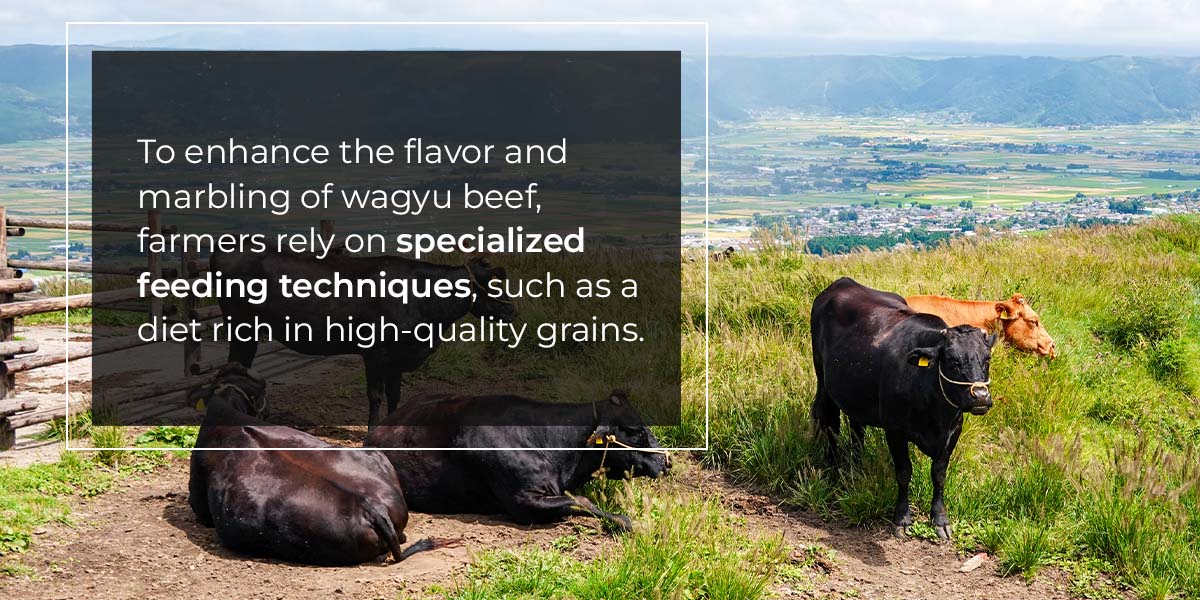
Wagyu is a Japanese cattle breed derived from native Asian cattle. The name ‘wagyu’ directly translates to ‘Japanese Cow,’ where ‘wa’ is Japanese and ‘gyu’ means cow. Wagyu cattle were originally bred in Japan for agricultural and draft work thousands of years ago.
Their physical endurance capabilities give these animals more intra-muscular fat cells, called marbling, which is a great energy source. To enhance the flavor and marbling of wagyu beef, farmers rely on specialized feeding techniques, such as a diet rich in high-quality grains. They also pay attention to the animals' well-being, sometimes including massage in their care. Collectively, these efforts enhance the animals' comfort and, ultimately, meat quality.
The Origin of American Wagyu
The introduction to American wagyu started with local farmer Morris Whitney. He was the first to import wagyu cattle in 1975, bringing two black and two red bulls onto U.S. soil. These bulls, named Judo and Rueshaw, were crossbred with female Angus cattle and Continental breeds. A few years later, the Japanese black females were imported, and the U.S. bred its first full-blood wagyu.
With tariffs on imported beef reducing, farmers in the U.S. started to produce more high-quality wagyu meat for Japan as more black and red wagyu were imported. In the 1990s, the Japanese government placed a ban on wagyu cattle exports.
With the incorporation of The American Wagyu Association in 1990, farmers could register their wagyu cattle. Through DNA parent verification, farmers can ensure they have full-blood or purebred cattle. It also opens up the opportunity to create a more sustainable, local wagyu meat production industry.
What Sets Wagyu Meat Apart
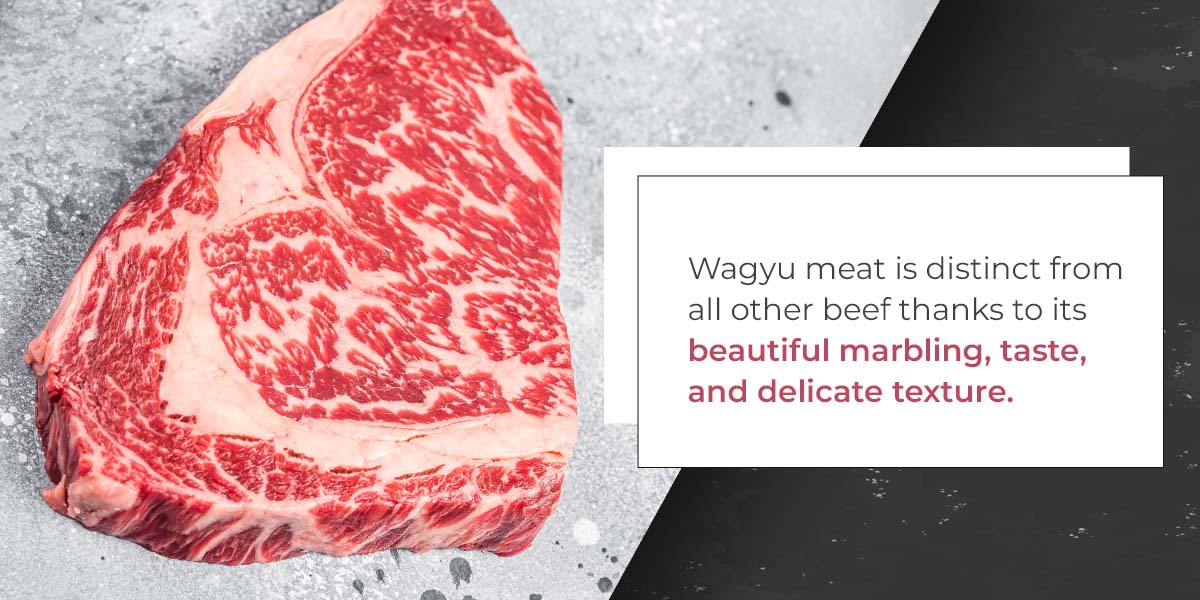
Wagyu meat is distinct from all other beef thanks to its beautiful marbling, taste, and delicate texture. As wagyu beef cooks, the marbled fat starts to melt. Its even distribution keeps the meat moist and tender while maintaining its rich, beefy flavor.
A unique aspect of wagyu breeding is grain fishing. This practice helps create optimal marbling by reducing the cattle's diet in the last few months of their lives. Grains decrease, and some farmers switch to a grass-fed or grass-finished diet. The cattle's weight is monitored closely to adjust their diet as needed, ensuring they achieve the desired marbling level.
Intramuscular Marbling
Wagyu cattle have a genetic predisposition to produce high amounts of unsaturated fats, which create a unique marbling pattern in the meat. In regular beef, fat often collects in large visible chunks on the edges, but in wagyu beef, it disperses throughout the muscle fibers to create a tender, juicy texture and rich flavor. Intramuscular marbling refers to these thin flecks and streaks of fat you see throughout the cut of meat.
Health Benefits
The beautiful marbling in this meat contributes to its nutrient profile. High-quality American wagyu meat can support heart health when you add it to a well-balanced diet. These potential health benefits come from:
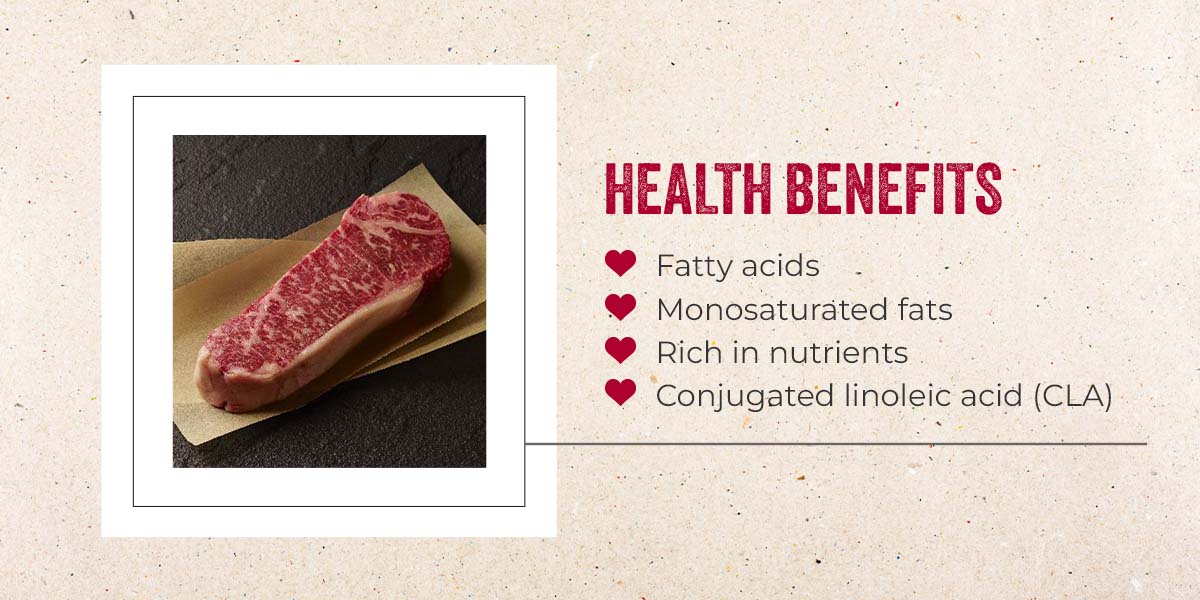
Types of Japanese Wagyu
There are various types of wagyu beef, each with unique characteristics and regional nuances. They also reflect each breed's rich heritage and meticulous breeding practices. Non-region-specific breeds producing this delicious meat include:
- Japanese Black: Kuroge Washu, or Japanese Black, were workhorses, but with cross-breeding in the Meiji Era. By 1944, they were certified as indigenous Japanese beef cattle. Even their lean meat has exquisite marbling, offering a melt-in-your-mouth texture.
- Japanese Brown: Akage Washu, red wagyu, or Japanese brown, is a dominant line originating in the Kumamoto Prefecture. It is a cross-breed of Simmental with Hanwoo or Korean Red. Its meat is firm and less fat-heavy than other wagyu beef, offering a mild beefy taste.
Kobe Beef
Kobe beef is one of the more popular types of wagyu beef, coming from Japanese Black cattle. It hails from the Hyogo Prefecture region in Japan and is rich and tender, with a buttery flavor and exceptional marling. Kobe beef has strict production regulations that include a specific cattle lineage, the Tajima strain of Japanese Black cattle, with rigorous grading standards and feeding regimes.
Hida Beef
Hida beef comes from Japanese Black cattle in the Hida region in the Gifu Prefecture. Cattle in Hida enjoy clean mountain water and a diet that enhances meat quality, creating a rich, savory flavor profile, fine marbling, and tenderness. Hida beef is often featured in traditional Japanese dishes like yakiniku or as premium steaks in upscale establishments.
Ohmi Beef
Also known as Ōmi beef, this meat comes from Japanese Black cattle in the Shiga Prefecture in the Ohmi region. In this region, cattle follow a strict feeding regimen as they are bred for optimal meat quality. It has an exceptional umami flavor and fine marbling characteristics. Its luxurious texture is why it is often added to traditional Japanese dishes like sukiyaki and shabu-shabu.
Matsusaka Beef
From the Matsusaka region in Mie Prefecture, this meat has superb marbling and a deliciously tender texture. Farmers ensure this by raising cattle in a stress-free environment, feeding them a high-quality grain diet. Like Kobe beef, Matsusaka beef is subject to stringent grading criteria to ensure only premium-quality cuts make it to market.
Yonezawa Beef
Yonezawa beef comes from the Yamagata Prefecture in the Tonezawa region, a climate that promotes optimal meat quality. Its meat has a rich, beefy flavor and beautiful marbling, making it versatile enough for various cooking methods. The Japanese Black cattle that create this meat are all virgin female cows.
American Wagyu Beef Guide
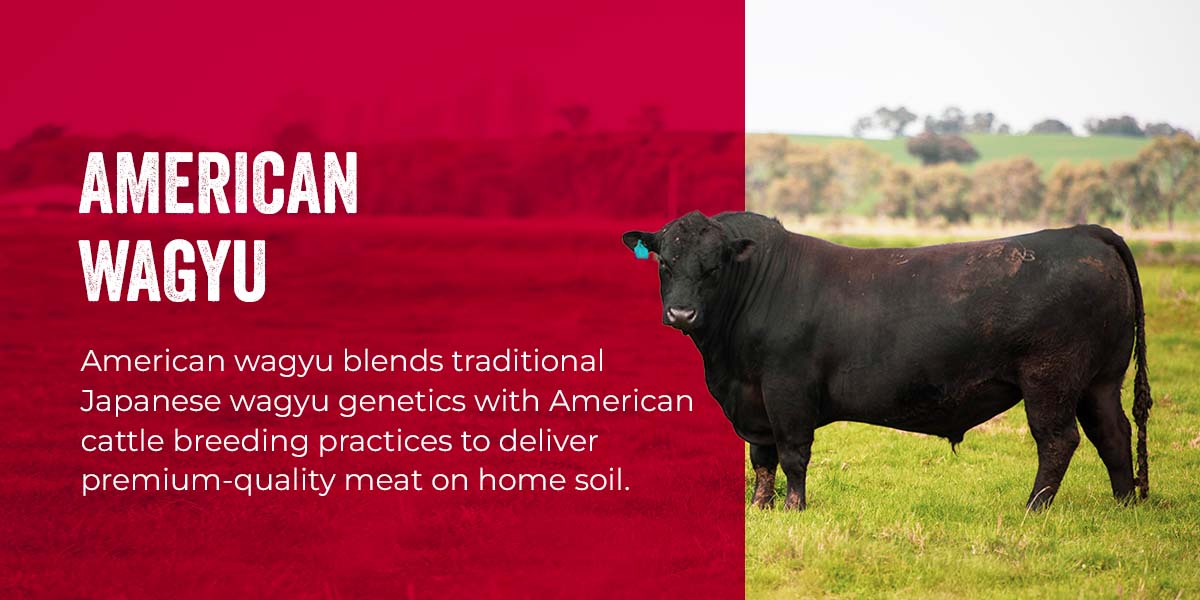
American wagyu blends traditional Japanese wagyu genetics with American cattle breeding practices to deliver premium-quality meat on home soil. Our Wagyu beef stands out for its exceptional marbling, which creates juicy, melt-in-your-mouth cuts. It is widely available in the U.S., making it a more accessible option for consumers looking for premium Wagyu beef.
High-quality forage plays a crucial role in the wagyu beefs' quality, directly contributing to the flavor and marbling. These animals will feast on a high-energy diet consisting of grains like barley and corn alongside hay and silage. The forage helps the animals maintain their digestive health, which ensures that they absorb essential nutrients from the grains and forage. Some breeders also include additional proteins through legumes like alfalfa.
American Wagyu Characteristics
The American wagyu breeds are known for their high-quality beef, which stands out in the culinary world. Since their arrival in the U.S., local farmers have produced full-blood, pureblood, and crossbred subsets:
- Full-blood: Full-blood wagyu have 100% Japanese wagyu genetics but are born and bred in the U.S. They offer the highest quality in terms of flavor, marbling, and tenderness.
- Pureblood: Pureblood wagyu contains an extremely high percentage of wagyu genetics and is directly descended from the original Japanese wagyu cattle.
- Crossbred: Some wagyu cattle are crossbred with other breeds like Angus. This practice combines the best qualities of both breeds, delivering improved marbling and tenderness when compared to traditional beef.
Marbling and American Wagyu
American wagyu vs. Japanese wagyu — how does the sought-after marbling compare? Through careful breeding, farmers ensure that local wagyu meat features impressive marbling, tenderness, and taste. The traditional Japanese genetics combined with American cattle-raising practices with fine streaks of fat distributed evenly throughout the meat. The high-quality intramuscular fat in American wagyu ensures that this meat is incredibly tender.
American Wagyu Beef Flavor
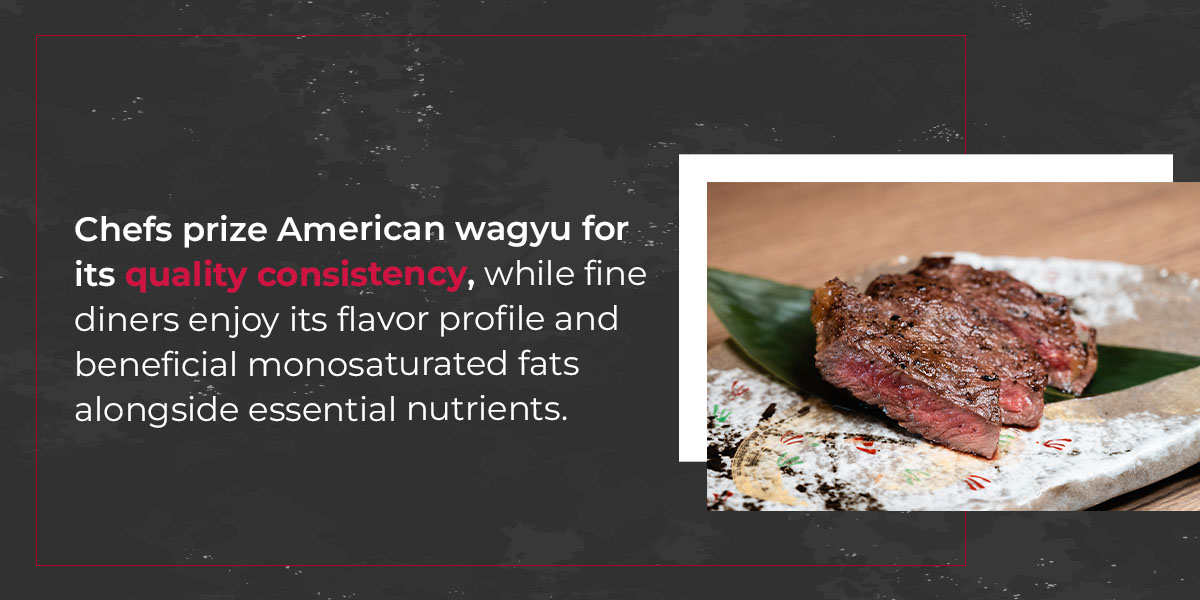
Chefs prize American wagyu for its quality consistency, while fine diners enjoy its flavor profile and beneficial monosaturated fats alongside essential nutrients. More characteristics include:
- Marbling excellence: American wagyu beef maintains abundant intramuscular marbling to create some serious umami flavor.
- Versatility: Wagyu meat shines, whether it is enjoyed as a fine roast, premium steak, or a burger.
- Succulency: American wagyu production, thanks to its high-fat content, ensures the meat is still tender and juicy.
- Exceptional flavor: Local wagyu meat is flavorful, with a deep, savory taste that is rich yet satisfying.
The Wagyu Grading System
The wagyu grading system evaluates beef based on its quality and yield. It helps consumers understand the meat's marbling, color, overall excellence, and texture. The beef is graded between the sixth and seventh rib, measuring its essential features. Wagyu and the United States Department of Agriculture (USDA) assess meat quality using different scales.
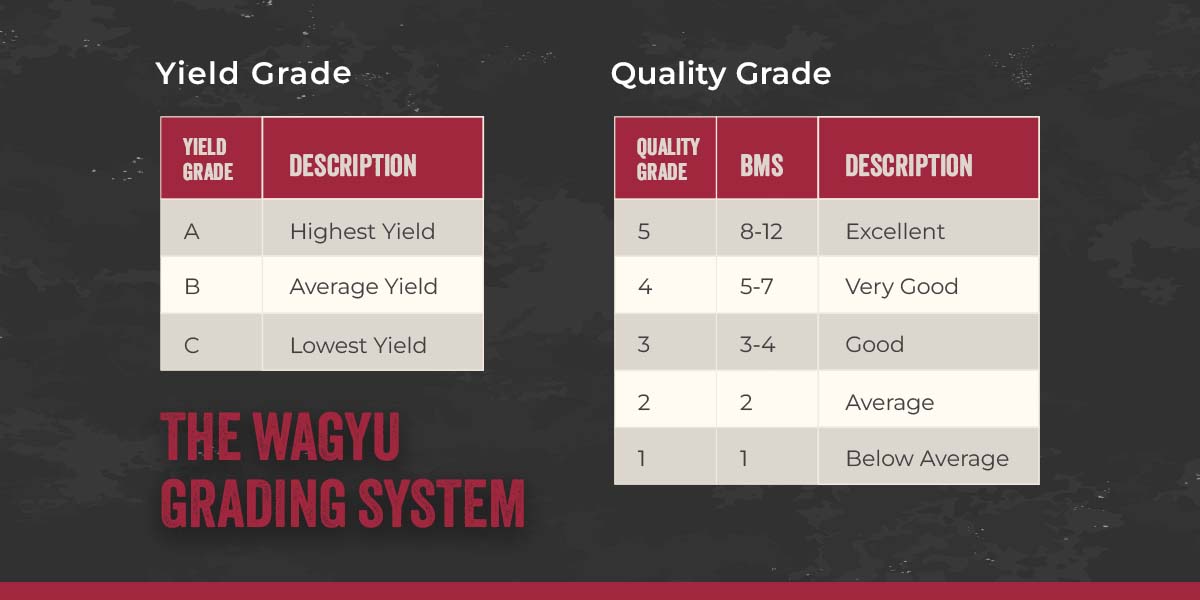
Yield Grade
Yield grade measures the amount of usable meat on wagyu cattle compared to the carcass weight. This measure categorizes meat into grade A, the highest yield, grade B for an average yield, and grade C, indicating the lowest yield.
| Yield Grade | Description |
|---|
| A |
Highest Yield |
| B |
Average Yield |
| C |
Lowest Yield |
Quality Grade
The quality grade assesses the meat's Color Standard (BCS), brightness, Beef Marbling Score (BMS), firmness, texture, and Beef Fat Standard (BFS). Scores range from one to five, with five being the highest quality.
| Quality Grade | BMS | Description |
|---|
| 5 |
8-12 |
Excellent |
| 4 |
5-7 |
Very Good |
| 3 |
3-4 |
Good |
| 2 |
2 |
Average |
| 1 |
1 |
Below Average |
The final grade combines yield and quality grades. For example, an A5 grade indicates that this beef has the highest yield and quality.
The Marble Score Scale
The creamy white fat that riddles wagyu beef is subject to a Beef Marble Score. The Japanese marble score scale runs between three and 12, with three reflecting the minimum marbling in a steak and 12 representing an almost white cut with marbling. American-style wagyu divides meat into three categories — Prime, Choice, and Select:
- Prime: Prime is the highest quality beef, with abundant marbling. It is ideal for grilling and roasting. Lobel's of New York only stocks prime wagyu beef cuts.
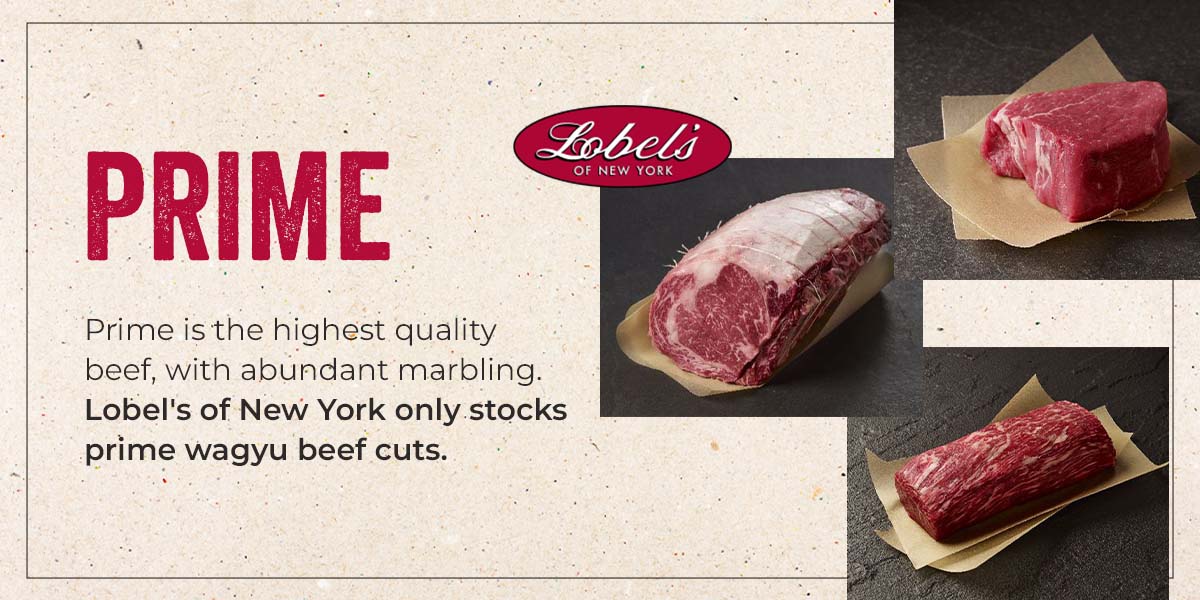
- Choice: Choice grade wagyu is high quality with less marbling than Prime cuts. It is still juicy and tender, perfect for a variety of recipes and cooking methods.
- Select: Select cuts are leaner than Prime and Choice grade. They have less marbling, making them optimal for marinating or slow-cooking methods.
The Comparison Between Wagyu and USDA Grading
Japanese and USDA yield grades all range from highest to lowest. Wagyu grading prioritizes marbling and fat quality, while the USDA system balances the marbling with overall meat quality. The USDA system also uses distinct categories with the numeric grades the traditional system relies on.
| System | Yield Grades | Quality Grades |
|---|
| Wagyu |
A, B, and C |
5, 4, 3, 2, and 1 |
|---|
| USDA |
1, 2, 3, 4, 5 |
Prime, Choice, and Select |
|---|
Cooking Wagyu Beef: Tips and Tricks
Due to its high-fat content, wagyu beef cooks differently from leaner cuts. Whether you enjoy a steak, make wagyu beef sliders, or attempt Sabu-Shabu, using the right cooking technique is essential. Preserve the meats' flavor and tenderness by opting for quick cooking methods like broiling, grilling, or searing.
Best Cooking Methods
Cooking with Wagyu requires special techniques to encourage its rich flavor and tender texture. Top cooking methods include:
- Broiling: Set the oven to broil and put the wagyu steak on a broiler pan. Broil each side for a couple of minutes to create a beautiful finish and sear.
- Grilling: Preheat the frill to a high heat and sear each wagyu steak for a couple of minutes on both sides. Reduce the heat and cook.
- Pan-seared: Heat a cast-iron skillet over medium-high heat, searing the steak for a couple of minutes per side. When a crust forms, reduce the heat to medium-low and finish cooking.
- Sous Vide: Set the water bath to your desired temperature and cook the wagyu steak in a vacuum-sealed bag for a couple of hours. Then, sear the meat in a hot pan to wrap things up.
Tips for Enhancing Flavor
Wagyu already has a delicious flavor of its own, so the idea is to enhance the meat's taste gently:
- Cook from room temperature: Allow wagyu meat to warm up to room temperature before cooking, as this will let the meat cook quicker and more evenly.
- Simple seasoning: Use salt and pepper or add garlic and rosemary for a pop of flavor.
- Rest the meat: Let the meat rest for a few minutes to let its juices redistribute.
- Avoid overcooking: Wagyu is prime when cooked medium-rare to medium. Overcooking can cause the fat to melt away, which reduces the meat's flavor and tenderness.
- Use high heat: Sear the meat on high heat, creating a crust that locks in moisture and boosts the flavor.
- Monitor the temperature: Invest in a thermometer and roast wagyu meat at a temperature of 250 degrees Fahrenheit to ensure the roast stays moist.
- Pair it nicely: Wagyu's rich flavor pairs perfectly with earthy mushrooms and leafy side dishes like creamed spinach or kale salad. Serve it with a bold red wine like syrah/shiraz or cabernet sauvignon. End the meal with a decadent dessert like tiramisu or mousse.
- Serve it correctly: Wagyu is typically served in smaller portions than standard steaks because it packs so much flavor in a single bite. Be sure to slice your wagyu thinly and against the direction of the grains — the visible muscle fibers — for maximum tenderness.
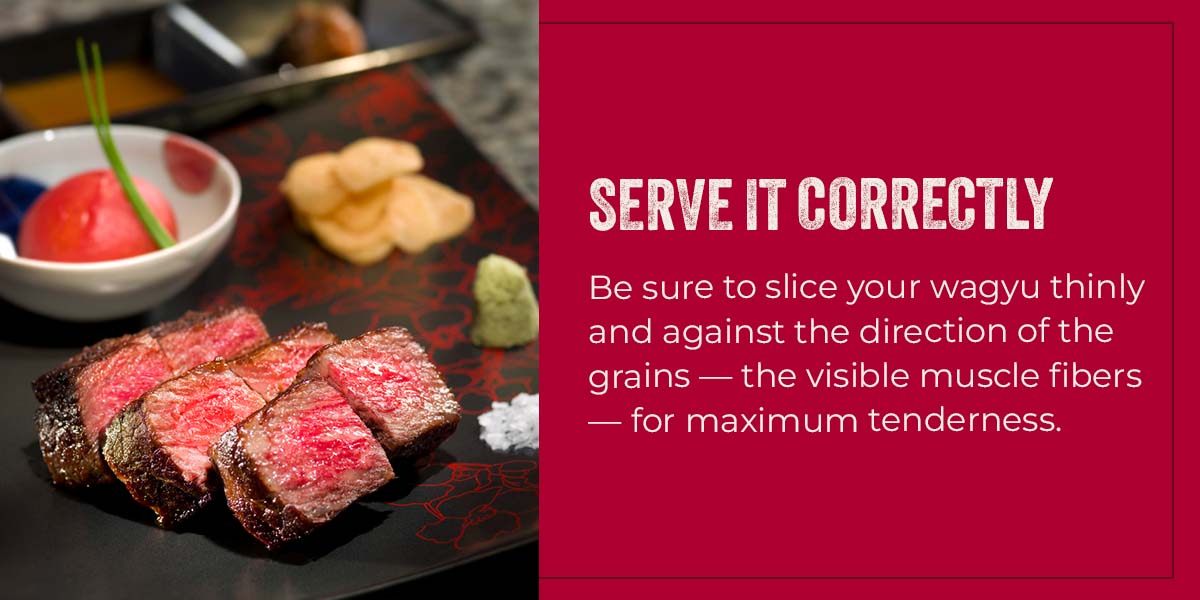
Wagyu Beef Frequently Asked Questions
As wagyu meat is continuously increasing in popularity, it is essential to fully understand the characteristics and benefits of this meat:
- What is wagyu meat? Wagyu meat comes from specific Japanese cattle breeds with high marbling, rich flavoring, and a tender texture.
- How is wagyu pronounced? Phonetically, it is pronounced as wāɡyo͞o or waa-gyoo.
- Can you freeze wagyu beef? Meat has the most flavor when it is fresh, but if it needs to be frozen, vacuum-seal it and follow Lobel's of New York's guidelines for meat storage as best practice.
- What does umami mean? When wagyu meat is described as having an umami flavor, it translates to ‘essence of deliciousness.’
- What is American wagyu? American wagyu is full-blood, purebred, or crossbred wagyu bred and processed in America.
- What cuts of wagyu beef are available? Lobel's of New York stocks wagyu steaks, roasts, ground beef, burgers, sliders, filets, tenderloins, briskets, short ribs, and braising cuts.
- How does wagyu meat taste? Wagyu is a buttery, fat-forward beef flavor. Specific profiles vary, depending on the type and classification. The biggest difference between wagyu and regular beef cuts is that you won't be carving away — properly prepared cuts will melt away in your mouth.
- How do I choose a cut of wagyu? Regardless of which wagyu cut you choose, check for a red coloration and slight firmness to touch. Lobel's of New York carries only the finest Wagyu options, so you know you're getting quality with every order.
Buy American Wagyu Beef at Lobel's of New York
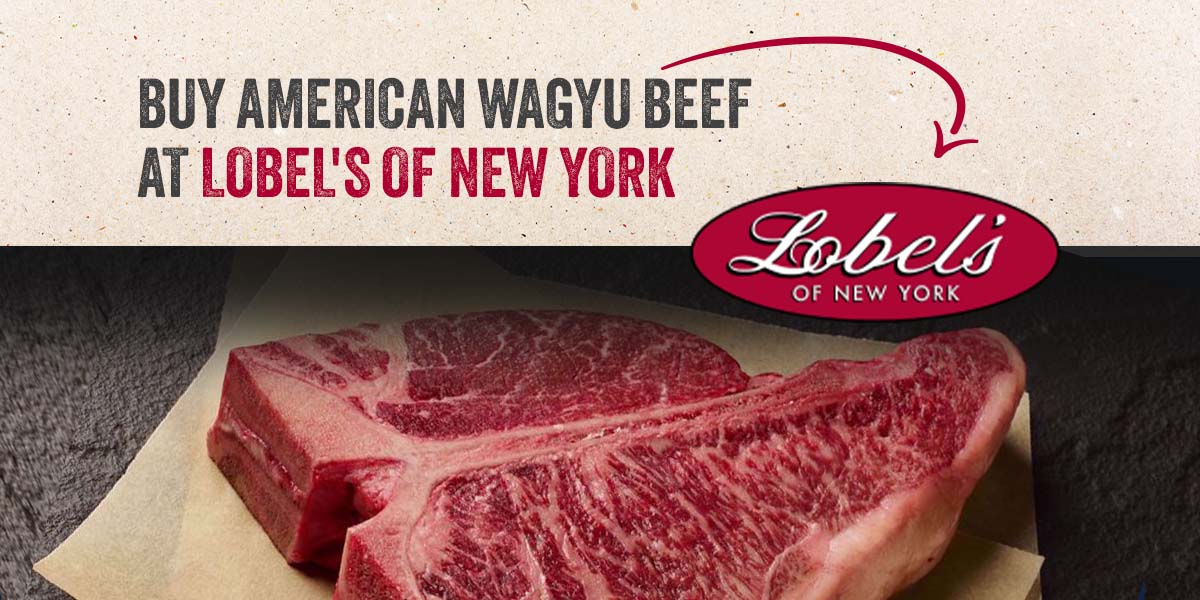
American wagyu Production is a testament to the blending of Japanese tradition and American innovation in the realm of premium meats. Local breeding relies on the cattle's genetics, coupled with specific feeding techniques and extra care. These factors contribute to the development of fine marbling within the muscle tissue. Whether you enjoy it as a steak, in a fine-dining creation, or in artisan burgers, wagyu beef is for everyone.
Freshness is the hallmark of Lobel's of New York beef, ensuring you receive meat that is at its peak of flavor, juiciness, and tenderness. For over 175 years and six generations of master butchers, the Lobel's of New York family has provided Americans with never-frozen Prime beef products and outstanding customer service. Our American wagyu score nine points or higher on the 12-point marbling score scale.
Shop premium American wagyu beef from Lobel's of New York. We offer expedited delivery via FedEx Overnight to ensure your order arrives at your doorstep at the peak of its freshness.
